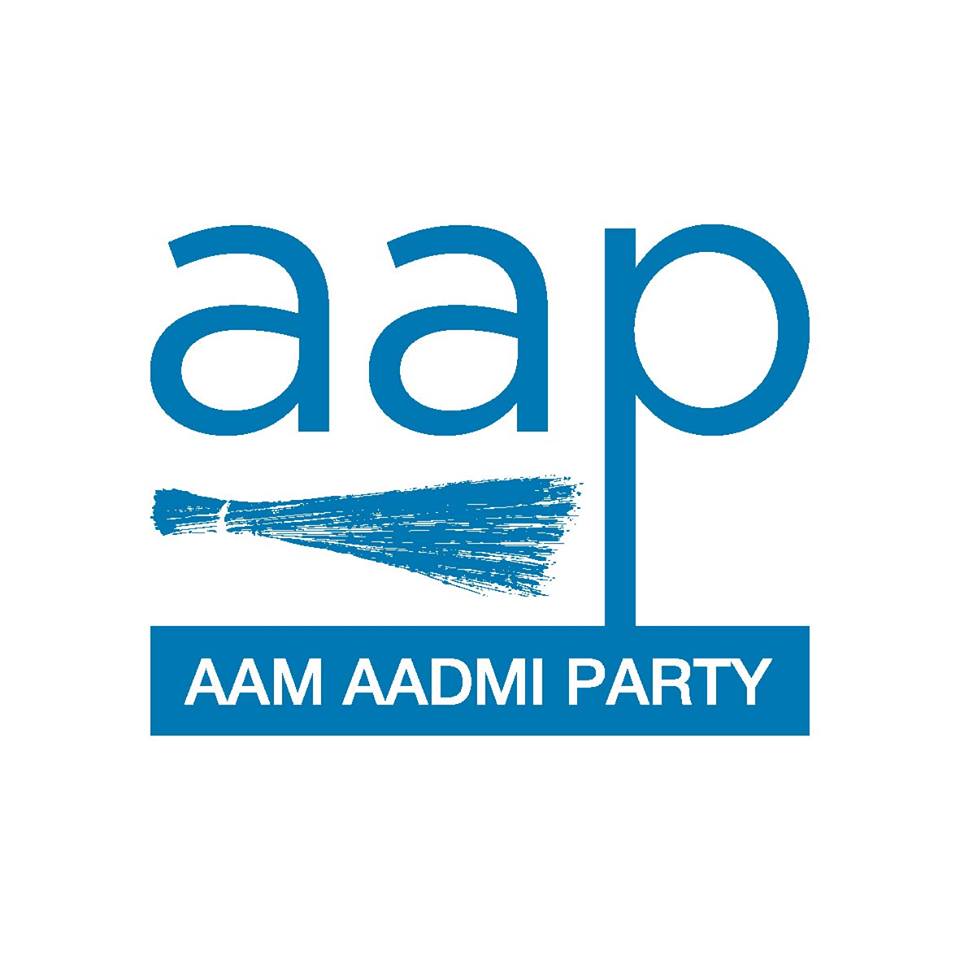

The AAP Delhi Government has been working on developing the comprehensive action plan on Yamuna Cleaning for the last few years and has conducted several successful pilot projects using new technologies.

Yamuna Cleaning Action Plan Dec 2020
On 7th Dec 2020, the AAP Delhi government came up with a comprehensive Yamuna Cleaning Action Plan. Its main components were upgradation of sewage treatment plants (STPs), connecting every household to the sewage system and in-situ treatment of untreated water.
As per this ambitious plan, no dirty water will be flowing into the Yamuna by December 2022 as all drains carrying sewage into the river will be tapped. 34 WTPs will treat 577 million gallons of waste water per day with a sewage network of above 9000 kms across.
Several important decisions/steps were taken to address the Yamuna water pollution issue:
- DJB will revive an ash pond of the Rajghat Power Plant to a 42-acre lake at a cost of ₹36.51 crore. For this, treated water from the STP at Delhi Gate (15 MGD capacity) will be used. Currently, treated water is discharged into the Yamuna. This is estimated to be completed in 18 months. This effort will reduce the organic load pollutant flowing into the Yamuna by 675 kgs.
- Construction of 14 mini-sewage treatment plants under the Najafgarh drain zone was approved by Dec 2019, along with laying of an internal sewage system in Somesh Vihar, Jhuljhuli and Dichaon Kalan group of colonies, covering a population of around eight lakh. The treated water from these plants will be used to revive 56 waterbodies in the area. This polluted water will no longer flow into the Yamuna.
- The high quality treated sewage water from the Coronation Pillar Water Treatment Plant would be taken to Palla and dumped into the Yamuna. The diluted water would then be lifted again 11 km downstream in Wazirabad for further treatment.
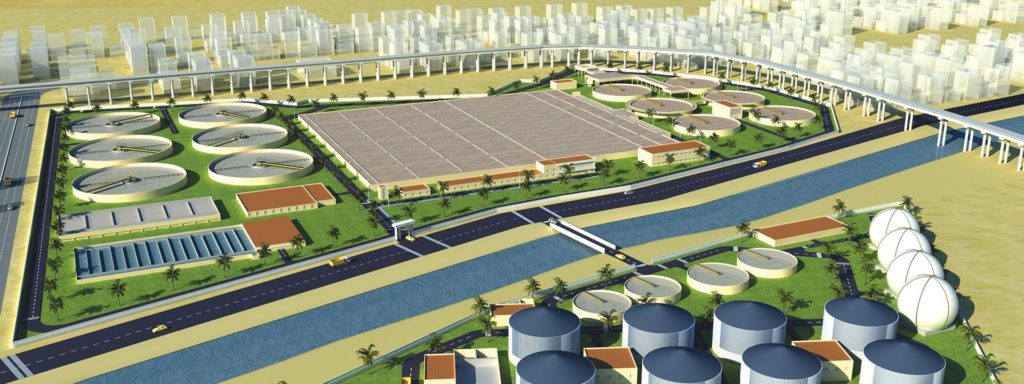
(Source: L&T Website)
This project, the first of its kind ever in India, will give an additional 95 MGD of water by December 2024.
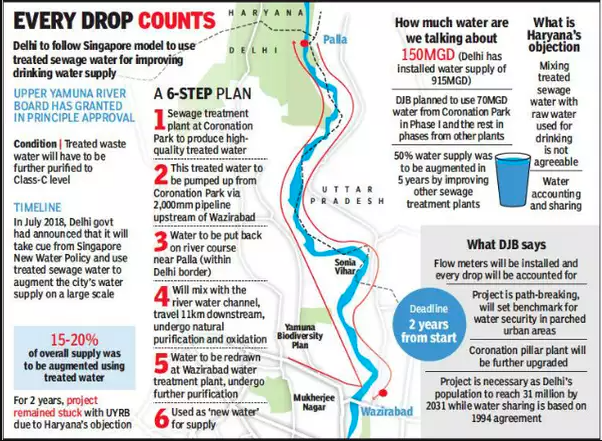
(Source: Times of India)
- 16 “natural STPs” have been planned to treat sewage entering the Yamuna. (More details are in “Water – Reviving the Ecosystem”.)
The natural sewage treatment plants (STPs) have a sedimentation tank where the suspended solids are first allowed to settle, after which the water is passed through four chambers and multiple compartments which have beds of pebbles that act as filters to clean the sewage.
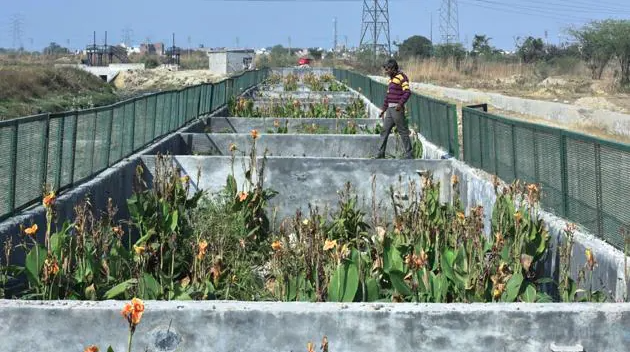
The pilot natural Sewage Treatment Plant (STP) at Bawana.
(Source: Hindustan Times)
- The Mukhyamantri Muft Sewer Connection Yojana that was announced on 19th Nov 2019 is also designed to avoid dumping of wastewater into storm water drains and the Yamuna. It covers those households where sewage lines have been laid but residents have not installed sewers on account of high cost. As many as 2,34,000 houses in 787 colonies are set to benefit from the scheme.
Under the new scheme, consumers who apply for a connection would not have to pay development charges, connection charges or road cutting charges.
As per the government’s estimation, a 25 sq m house would save over Rs 19,000 under the scheme and a 100 sq m house would save more than Rs 26,000.
(Source: DDC Performance Report 2015-2019)

Yamuna Cleaning Cell
Key problem areas identified by the Delhi Government:
- 22 km stretch between Wazirabad to Okhla accounts for about 76% of the pollution in the river.
- 720 MGD (million gallons a day) of sewage is generated in Delhi. Nineteen STPs having a cumulative treatment capacity of 597 MGD treat this sewage.
After having studied the issues in depth, on 18th Nov 2021, CM Arvind Kejriwal announced the Yamuna Cleaning Cell (YCC) that will work to fulfil the following Six Point Action Plan:
Six-Point Action Plan for Yamuna Cleaning
The YCC will work to fulfil the following Six Point Action Plan:
- Sewer treatment plants:
- New STPs like the ones being built at Coronation Pillar, Okhla, Kondli, Rithala
- Increasing the capacity of existing STPs
- Using new technology in existing STPs to improve quality of treated water to 10/10 purity level
- Drains:
- In-situ sewer treatment technique for 4 big drains that discharge polluted water into the Yamuna – Najafgarh, Badshahpur, Supplementary and Ghazipur drains
- Some drains to be diverted to treatment plants and others to be given in-situ treatment
- Industrial Waste:
- Crackdown on polluting industries through the YCC
- Effluent Treatment Plants to be made effective
- Jan Suvidha Complexes:
- Numerous Jan Suvidha Complexes in JJ (jhuggi-jhopdi) clusters are discharging sewage into storm water drains. These will be connected to the sewer network.
- Individual Sewer connections:
- Even in places where the sewer network exists, individual residences have not applied for the sewer connection (to connect their residence to the sewer network) and are discharging their sewage into storm water drains. Now this work will be taken up by the Delhi Government for all houses at a nominal charge without the need for an application. On 11th Nov 2021, the AAP Govt set an ambitious target to connect all households to the sewer network, thereby preventing any wastewater discharge into the Yamuna. A deadline of 31st Mar 2022 is set to disconnect all sewer lines polluting the drains.
- Desilting and rehabilitation of entire sewerage network
This 6-point Action Plan will enhance the sewage treatment capacity from the current 600 MGD towards the requirement of 750-850 MGD.
The AAP Delhi Government has set itself the target of 2025 for a clean Yamuna.

Construction of Check Dams & Weirs Across Drains
Check dams built on major drains have substantially reduced pollution levels. Construction of weirs (low check dams) on drains flowing into the Yamuna have been shown to substantially reduce pollutants like ammonia and suspended solid wastes and bringing down biological oxygen demand (as per lab test results revealed by the Delhi government on 27th Feb 2022).

(Source: Tweet by RamKumarJha)

Sealing of Polluting Industries
On 26th Jan 2022, the Delhi Government’s Yamuna Cleaning Cell stepped up its efforts to take punitive action against polluting industries. 11 teams were formed to survey industrial and redevelopment areas to catch violators of norms.
These teams will also have Delhi State Industrial and Infrastructure Development Corporation (DSIIDC) and Delhi Pollution Control Committee (DPCC) members. The assistant Chief Engineers of Delhi Jal Board (DJB) will be heading these teams. Surveyors from Jamia University were also roped in for this drive.
According to DPCC, around 2000 water-polluting industries are currently operating in Delhi in just the notified industrial areas. If an industry is not connected to any common effluent treatment plant (CETP), they shall be issued a notice. If the industry still does not comply, it will be sealed and further notices will be issued to discoms and DJB to disconnect water and electricity supply to the unit.

Using Treated Yamuna Water to Rejuvenate Lakes
On 29th Dec 2021, the AAP Delhi Govt decided that polluted water from neighbouring states that is flowing into the Yamuna will be treated in the Narela Sewage Treatment Plant (STP) first. This water will then be released into the lake in Tikri Khurd.
The capacity of the Narela STP will also be increased. The plan is to recycle 15 MGD of polluted water coming from neighbouring states.

Rejuvenating the Najafgarh drain
The Delhi Government plans to use the innovative technique of floating wetlands to rejuvenate the Najafgarh drain. For this, an in situ treatment has been planned in coordination with the irrigation and flood control department and DJB by February 2022.
The process will help filter and treat the water in the drain itself. This will also save the cost of making new sewage-treatment plants. The treatment of wastewater via the floating wetlands will help boost the dissolved oxygen levels, which is necessary for supporting aquatic life.

Reviving the Rithala STP
DJB is rehabilitating the 40 MGD Rithala STP to ensure that all water flowing into Yamuna is treated and remains within the standard parameters. The work has been slow so the agency has been directed to complete it by June 2022.

Completion of the Interceptor Sewage Project (ISP)
The much-awaited and ambitious Interceptor Sewage Project (ISP), touted to be the game-changer for Yamuna’s pollution problems, has been completed by Delhi government by mid-Feb 2022.
Delhi Jal Board (DJB) said the project was an integrated approach towards zero sewage flow as it would treat a substantial amount of sewage flowing into the river and drains. Targeted at cleaning a 22 km stretch of the river, the plan is to trap minor drains discharging sewage into Delhi’s largest drains — Najafgarh, Supplementary and Shahdara.
Beautification & landscaping of adjoining areas to these drains are also underway. The following is an artist’s impression of how they will look upon completion.
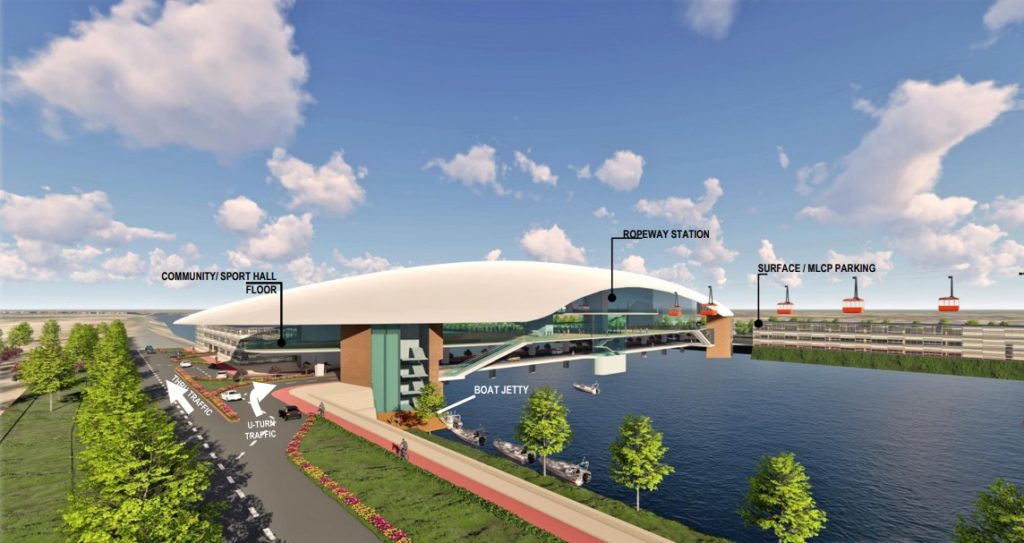

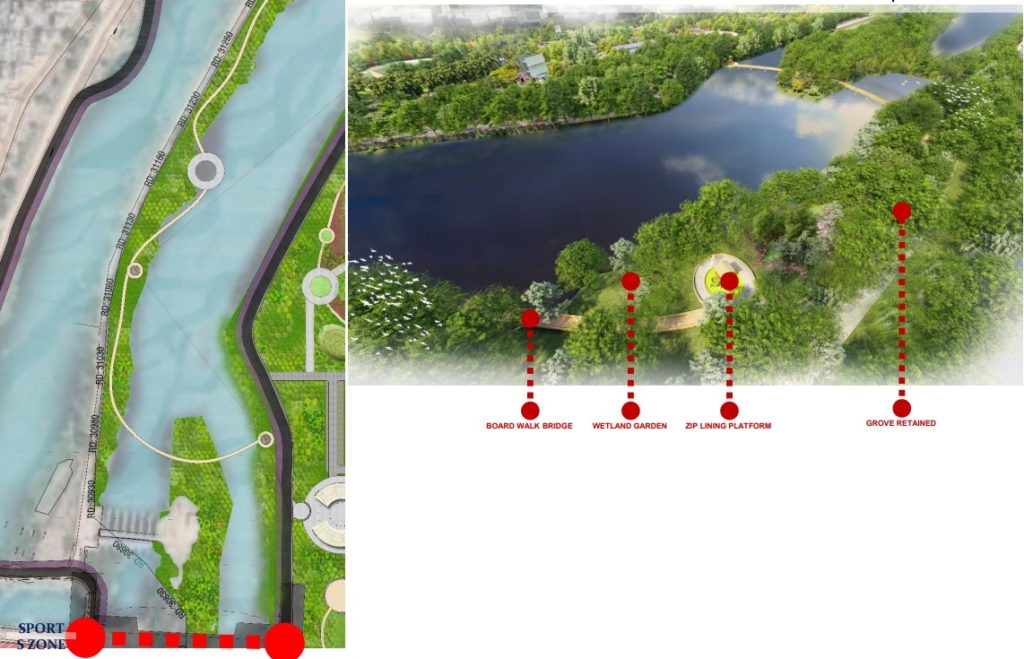

(Source: Tweet by Satyendar Jain)
Built at Rs 2,454 crore, Delhi government has implemented the project in six packages with seven sewage treatment plants (STPs). Waste water flowing in drains is being trapped and diverted to STPs for treatment. The plants purify the untreated wastewater and generate gases to run themselves. The cost includes operation and maintenance for 10 years.
The work for treating 238 million gallons per day (MGD) of sewage out of the targeted 248 MGD from the minor drains was completed by mid-Feb 2022 and the project will be fully operational soon.
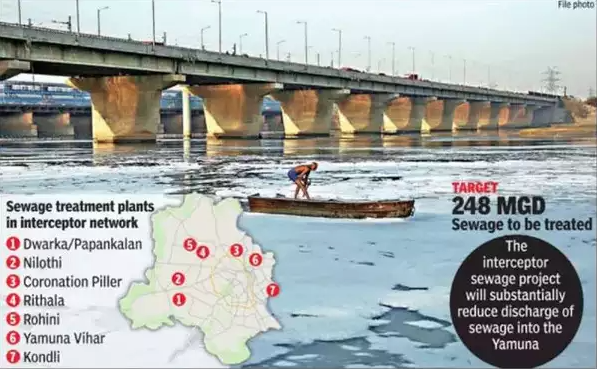
(Source: Times of India)


